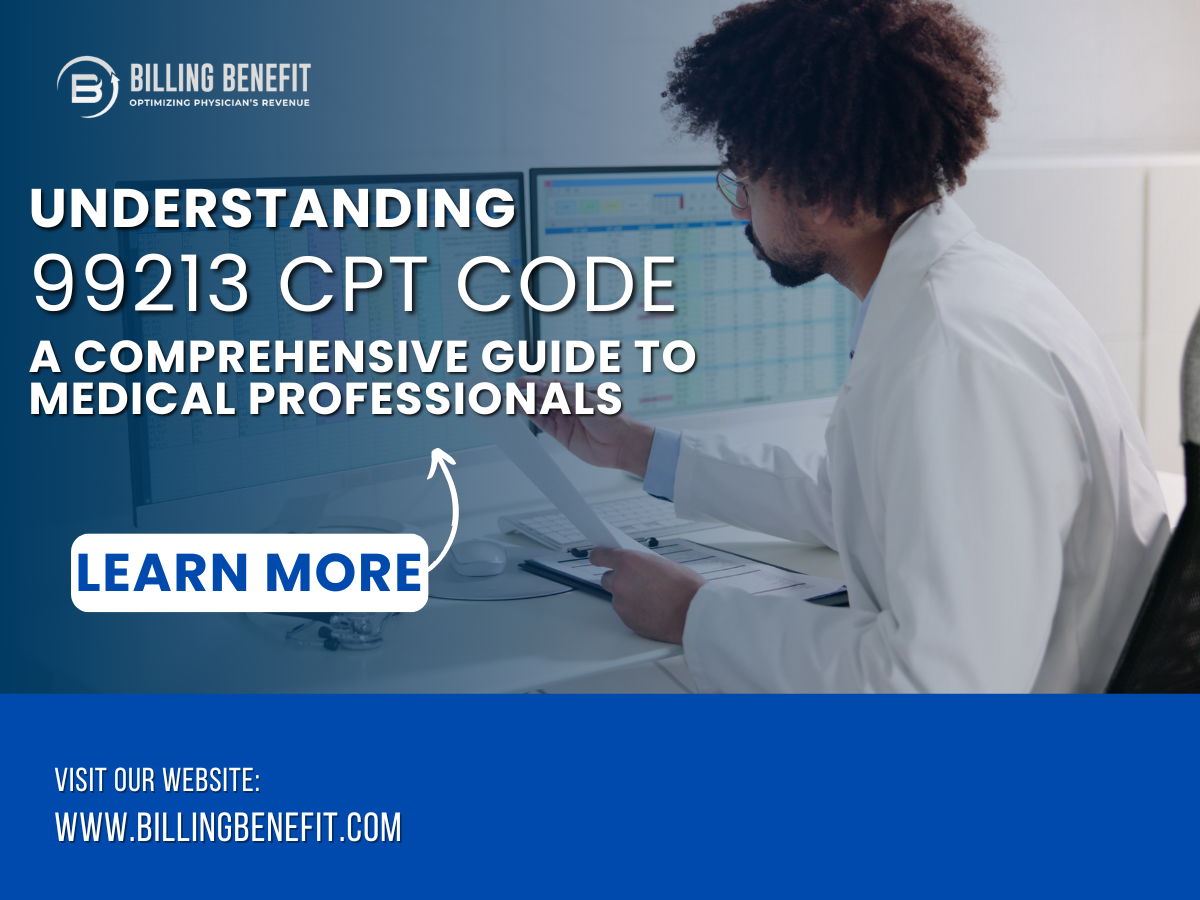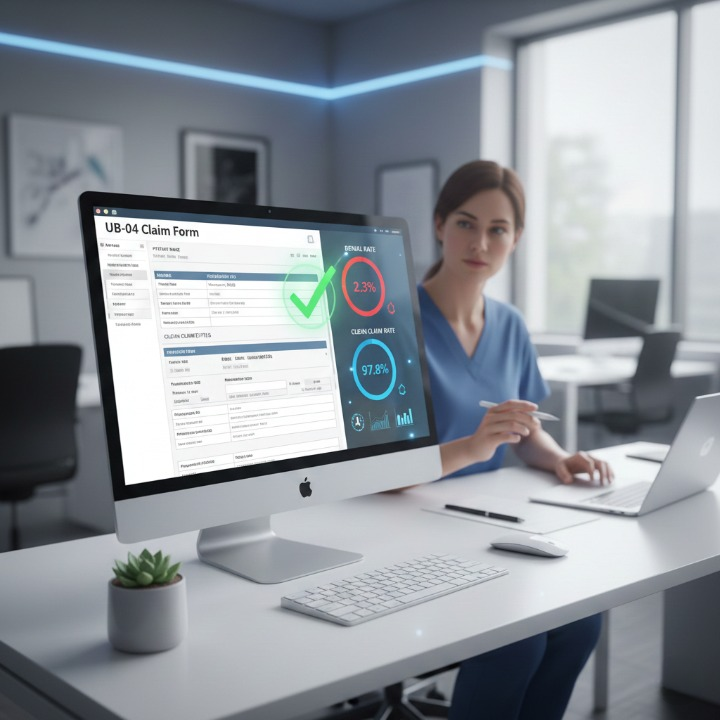The 99213 CPT code is a critical component of medical billing and coding, representing a specific type of patient encounter in outpatient settings. Understanding this code is essential for healthcare providers, coders, and billing specialists to ensure accurate documentation and reimbursement. This article delves into the intricacies of the 99213 CPT code, providing a detailed explanation of its description, proper usage, and documentation requirements.
99213 CPT Code Description
The 99213 CPT code description is pivotal in categorizing the level of service provided during a patient visit. Providers specifically use this code to denote an established patient visit involving a moderate level of medical decision-making (MDM) and typically requiring 20-29 minutes of their time on the date of the encounter. They commonly utilize this evaluation and management (E/M) service in outpatient settings, such as physician offices or clinics.
What Defines a 99213 Visit?
A 99213 visit is characterized by several key factors:
- Medical Decision-Making: The MDM complexity is moderate, meaning the provider addresses conditions of moderate severity.
- Patient History: The provider takes a detailed history, including a review of the patient’s current symptoms, past medical history, and relevant social or family history.
- Physical Examination: A focused physical exam is performed based on the patient’s presenting symptoms.
- Time Spent: The provider spends approximately 20-29 minutes face-to-face with the patient, which includes counseling and coordination of care.
Proper Usage of CPT Code 99213
Correctly using the CPT code 99213 is crucial to avoid potential billing issues or claim denials. Providers must ensure that the documentation meets the criteria outlined by the Centers for Medicare & Medicaid Services (CMS) and other insurance carriers. The following elements should be present in the medical record to justify the use of the 99213 code:
- Chief Complaint: Clearly document the patient’s primary reason for the visit.
- Detailed History: Include a comprehensive review of systems (ROS), past medical, family, and social history as appropriate.
- Focused Exam: Conduct and document a physical examination that corresponds with the patient’s complaints.
- Moderate MDM: Ensure that the medical decision-making is of moderate complexity, which may involve ordering and reviewing diagnostic tests, prescribing medications, or discussing treatment options.
- Time Documentation: While time is not always the determining factor for coding, accurately documenting the time spent during the visit is crucial, especially when time is the primary driver for code selection.
Common Scenarios for 99213 CPT Code
Providers often use the 99213 CPT code in various clinical scenarios, reflecting a broad range of patient interactions. Some common examples include:
- Follow-Up Visits: Patients returning for follow-up on chronic conditions like hypertension or diabetes.
- Management of Stable Conditions: Visits where patients are seen for routine management of stable, chronic conditions.
- New Complaints with Moderate Complexity: When a patient presents with a new complaint that requires a moderate level of decision-making, such as the evaluation of a new skin rash or worsening of an existing condition.
99213 CPT Code vs. Other E/M Codes
Understanding the differences between code 99213 and other E/M codes is vital for accurate coding. For instance, 99212 typically represents a straightforward visit with minor complaints requiring less time and decision-making, while 99214 involves a higher level of complexity and longer patient interaction.
- 99212 vs. 99213: A 99212 visit is for an established patient with straightforward MDM and requires about 10-19 minutes of the provider’s time.
- 99214 vs. 99213: A 99214 visit is for more complex cases, where the provider engages in a more detailed examination and decision-making, typically requiring 30-39 minutes.
Documentation Requirements for 99213 CPT Code
To comply with CPT code 99213 guidelines and ensure proper reimbursement, thorough documentation is essential. Providers should meticulously document the following:
- Chief Complaint: A clear statement of why the patient is being seen.
- History: Include detailed notes on the patient’s symptoms, previous conditions, and any relevant family or social history.
- Examination: Document the findings from the physical examination, correlating them with the patient’s complaints.
- Assessment and Plan: Outline the diagnosis, treatment plan, and any follow-up instructions.
- Time Spent: Document the total time spent with the patient, especially if the visit duration influences the code selection.
Challenges in Using the 99213 CPT
Despite its common use, providers face challenges associated with the 99213 CPT. One significant issue is under-documentation, where providers fail to capture the necessary details to justify the code. Another challenge is the overuse of the code, where providers apply it to visits that do not meet the moderate complexity criteria, leading to potential audits and claim rejections.
Avoiding Common Pitfalls
To avoid common pitfalls with code 99213, consider the following tips:
- Consistency in Documentation: Ensure that the documentation consistently supports the level of service billed.
- Training and Education: Regularly update coding knowledge to stay abreast of changes in E/M guidelines.
- Utilize Audits: Conduct internal audits to identify and correct potential coding errors before submitting claims.
Reimbursement Considerations for CPT Code 99213
Understanding the reimbursement rates and guidelines for CPT code 99213 is essential for maximizing revenue and minimizing claim denials. Medicare and other insurance carriers provide specific reimbursement rates for this code, which vary based on geographic location and other factors.
FAQs
What is the 99213 CPT used for?
The provider uses the 99213 CPT for an established patient visit with moderate complexity, requiring 20-29 minutes of their time.
How is the 99213 CPT different from 99212?
99213 involves moderate complexity and a longer visit time (20-29 minutes), whereas 99212 involves straightforward MDM with 10-19 minutes of face-to-face time.
What are the documentation requirements for 99213?
Documentation must include a chief complaint, detailed history, focused exam, moderate MDM, and time spent with the patient.
Can 99213 be used for telehealth visits?
Providers can use 99213 for telehealth visits if the encounter meets the same criteria as in-person visits.
What is the reimbursement rate for CPT 99213?
Reimbursement rates for 99213 vary by payer and location, but it generally falls within the moderate range for outpatient services.
How do I ensure compliance when using 99213?
Ensure compliance by adhering to documentation guidelines, avoiding overuse, and regularly updating your coding knowledge.
Conclusion
The 99213 CPT plays a vital role in medical billing and coding, representing a common but essential service in outpatient care. Proper usage of this code requires a thorough understanding of its description, documentation requirements, and potential challenges. By adhering to best practices and staying informed about updates to E/M coding guidelines, healthcare providers can ensure accurate billing and optimal reimbursement for their services.










